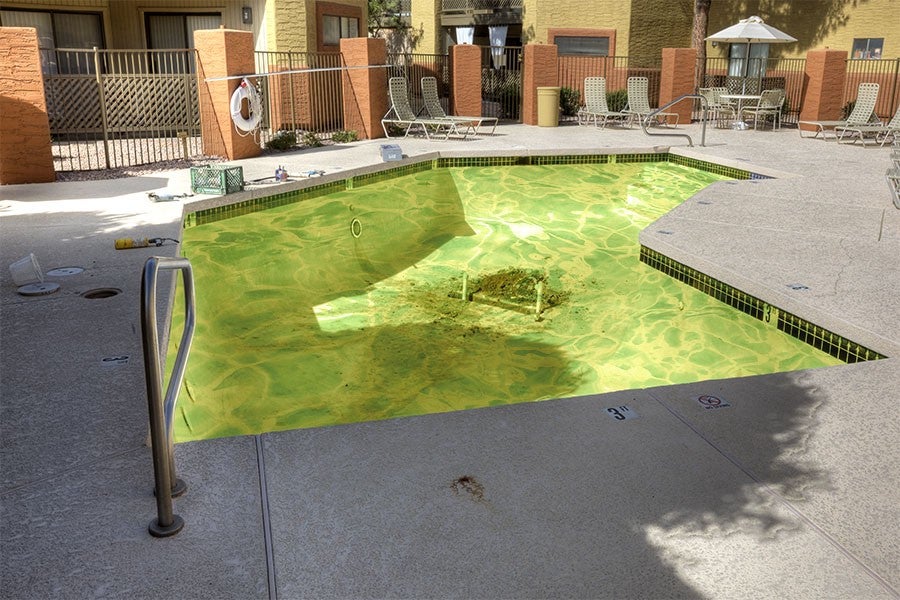Try not to think about this the next time you go swimming: Pools are disgusting. You could even argue that they’re basically little more than giant, swimmable, chlorine-filled toilet bowls. According to one Canadian study, there’s an average of eight gallons of pee in a typical 110,000-gallon pool. Considering the general size of the human bladder (which squeezes out around 300 milliliters per pee), that must mean the piss came from, at minimum, 100 different people.
“Oh, but what about that strong, chlorine-y ‘pool smell’?” you ask. “That eye-watering chemical odor must mean they’re clean, right?” Welp, sorry, but that’s not chlorine you’re smelling, amigo: According to environmental engineering professor Ernest R. Blatchley III, that’s the smell of trichloramine, a gas created when chlorine reacts with the chemicals in your urine. The stronger the “chlorine” smell, the more piss there is in that pool.
Now, who wants to see my cannonball?
All of this, of course, raises the question of what happens to all that pee, and the answer depends on whether the pool is ever totally drained. Everyone treats their pool differently: According to swimmer messageboard chatter about this sort of thing, public pools sometimes change their water twice a year; others do it every five years; and some never do it at all, because water is expensive and stuff.
But say a pool isn’t immediately drained: The short answer is, the pee goes nowhere! Instead, the chlorine changes the urine into different chemicals. Some of it turns to gas, according to Blatchley (that’s the “eau de trichloramine” aroma), but it mostly turns to nitrate. And while nitrate makes good plant fertilizer, it does nothing for humans — except accumulate in a swimming pool until the water is completely replaced, that is.
Unsurprisingly, that swamp of chemicals isn’t so great: According to a 2010 study, all the shit they use to treat pool water creates mutagens, aka stuff that could cause cancer. Called “disinfection byproducts,” or DBPs, they’re formed when swimming pool disinfectants mix with “human inputs” — the stuff we refer to as piss, sweat, skin cells, you name it. Gross as it is, whether it’s actually dangerous is a matter of opinion: The same study found that the pools they sampled contained comparable levels of DBPs to that found in your tap water.
Of course, pee is far from the only unwanted substance in the average public pool, so let’s rank them in order, from “harmless” to “maybe chill on the pool deck for the afternoon”…
Spilled Booze
According to the internet (always a trustworthy source!), Marilyn Monroe supposedly took a bath in champagne once. No one seems to know how that worked out, but realistically, unless you’re in a tiny, plastic, backyard kiddie pool, the amount of adult beverage that might end up in a pool is infinitesimal compared to the amount of water diluting it, so don’t sweat it.
Sweat, Hair, Skin Cells, Etc.
This is one reason those signs by the pool that nobody ever reads tell everyone to shower before getting in. Sweat, skin cells and whatever else is on your body could turn into disinfectant byproducts — those mutagens from earlier — when they mix with the pool-cleaning solution. Not much you can do about this, though, aside from forcing everyone to shower.
Blood
It’s in there, whether it’s from someone’s wound, an erupted zit or menstruation. And blood, too, can cause those disinfectant byproduct mutagens. But let’s be real: We’re not talking about The Shining levels of blood here. And if we are, maybe go swim somewhere else?
Sunscreen/Cosmetics
These also mix with disinfectants, and according to science, can create some nasty toxic precursors. We already know that sunscreen contains a bunch of mysterious chemicals. The state of Hawaii recently banned sunscreens containing two kinds of chemicals because the pale folks who slathered or sprayed them on and went snorkeling were unwittingly killing all the coral. If you can see a bunch of sunscreen slime skimming on the surface of a pool (kiddie pools often have this), that’s not a good sign.
Fecal Matter
Yeah, this is pretty bad. If you see a child wearing a diaper in the pool, GTFO. That shit — literally, shit — can make anyone sick. Specifically, it’s the bacteria in fecal matter, like e. coli, that’s bad for you. The really bad news is, there’s probably at least some in whatever pool you last swam in. According to the Centers for Disease Control and Prevention, people have about 0.14 grams of feces on their bottoms (nobody’s perfect, right?), which likely dislodges in a swimming pool. Here’s where chlorine — that not-so-sweet-anymore smell — comes to the rescue, although the CDC says it could take up to a day to kill today’s stronger, more highly evolved germs. In the meantime, hello, diarrhea! Or possibly itchy hot-tub rash, or even respiratory illness.
Although all of this is revolting, in the grand scheme of #poollife, there are far more important things to worry about: Drowning, diving into shallow water, running on the pool deck and margaritas are all way more dangerous. So long as you’re not deliberately drinking the pool water, you’ll probably be okay. And if you are planning on drinking the pool water after reading this, you might want to consider professional help.

